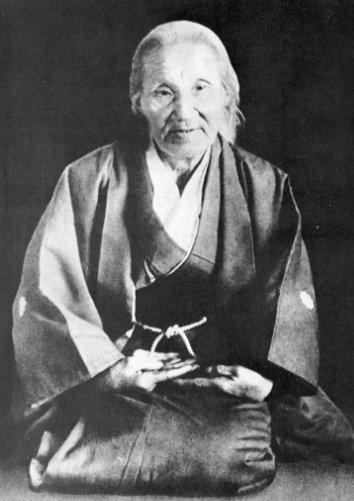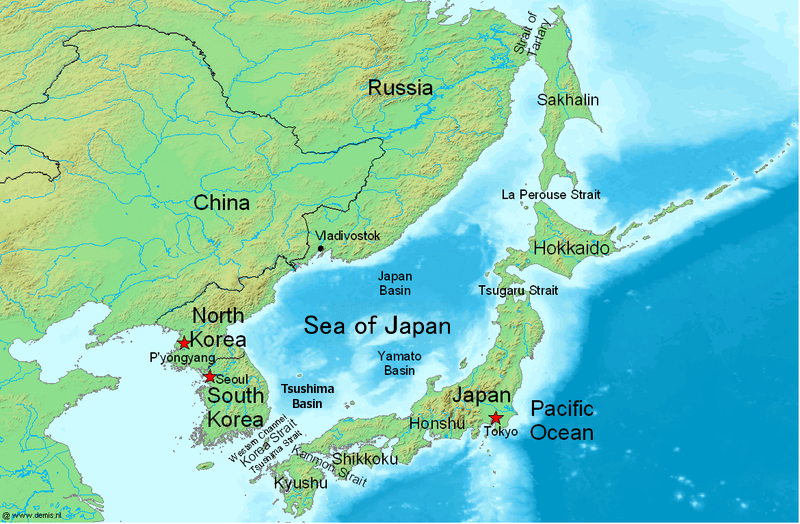|
Kutsujima
is a volcanic island in the Sea of Japan, 2.5 km from the coast of the Kyoto Prefecture in Japan. Kutsujima Island is administered as part of Maizuru city. The island consist of two islets - the smaller northern (where highest elevation rocks are located) is or and larger southern is or Kutsujima has been recognised as an Important Bird Area (IBA) by BirdLife International because it supports populations of black-tailed gulls, Japanese murrelets and Swinhoe's storm petrels. Currently, the islets are designated as the Kanmurijima-Kutsujima Wildlife Protection Area, and any landing is prohibited. History According to inscriptions on Tango no kuni fudoki, the Kanmurijima and Kutsujima are the remains of the much larger island which submerged following an earthquake in 701 A.D. The topography of seafloor seems to support the claim, as the steep 60-meter cliff is located underwater off eastern coast of Kanmurijima and Kutsujuma, indicating a recent crustal fault. The ... [...More Info...] [...Related Items...] OR: [Wikipedia] [Google] [Baidu] |
Kanmurijima
is an island in the Sea of Japan administered under Maizuru in Kyoto Prefecture. It is about 2 km from Kutsujima, a similar smaller island. is located just midway between islands. A breeding ground for streaked shearwaters, the island was designated a Japanese natural monument (天然記念物, ''tennen-kinenbutsu'') in 1924. It has also been recognised as an Important Bird Area (IBA) by BirdLife International. Currently, the island is designated as Kanmurijima-Kutsujima wildlife protection area and any landing is prohibited. A recreational diving service is available though. History According to records of Tango no kuni fudoki, Kanmurijima and Kutsujima are the remains of a much larger island which submerged following an earthquake in 701 A.D. The topography of the seafloor seems to support the claim, as the steep 60-metre cliff is located underwater off the eastern coast of Kanmurijima and Kutsujima, indicating a recent crustal fault. See also * Amanohashidate ... [...More Info...] [...Related Items...] OR: [Wikipedia] [Google] [Baidu] |
Wildlife Protection Areas In Japan
in Japan are established by the Ministry of the Environment (Japan), Ministry of the Environment and, for areas of more local importance, by the Prefectures of Japan, Prefectural Governments in order "to protect and promote the reproduction of birds and mammals" in accordance with the 2002 (superseding the amended 1918 Law). The areas established have a maximum duration of twenty years (subject to renewal) and hunting is prohibited within them. are designated within the Wildlife Protection Areas in order to protect habitats and ecosystems. Classification of wildlife The wildlife of Japan is classified either as Game (food), game species or protected species. The former includes thirty species of bird and seventeen of mammal that are considered (1) able to withstand hunting (2) harmful to agriculture and forestry (3) useful for meat or other derivatives. These species include the brown bear, Asian black bear, black bear, Sika deer, Japanese deer, Japanese hare, Japanese quail, a ... [...More Info...] [...Related Items...] OR: [Wikipedia] [Google] [Baidu] |
Oomoto
file:Chouseiden.jpg, 200px, ''Chōseiden'' (長生殿) in Ayabe, Kyoto, Ayabe , also known as , is a religion founded in the 1890s by Nao Deguchi, Deguchi Nao (1836–1918) and Onisaburo Deguchi, Deguchi Onisaburō (1871–1948). Oomoto is typically categorized as a Shinto-based Japanese new religions, Japanese new religion. The spiritual leaders of the movement have always been women within the Deguchi family, along with Onisaburō as its founding ''seishi'' (spiritual teacher). Since 2001, the movement has been guided by its fifth leader, Kurenai Deguchi. Oomoto's administrative headquarters is in Kameoka, Kyoto (Onisaburo Deguchi's hometown), and its spiritual headquarters is in Ayabe, Kyoto (Nao Deguchi's hometown). Uniquely among Japanese religions, Oomoto makes extensive use of the constructed language Esperanto in order promote itself as a world religion. Oomoto has historically engaged in extensive interfaith dialogue with religions such as the Baháʼí Faith, Christia ... [...More Info...] [...Related Items...] OR: [Wikipedia] [Google] [Baidu] |
Sea Of Japan
The Sea of Japan is the marginal sea between the Japanese archipelago, Sakhalin, the Korean Peninsula, and the mainland of the Russian Far East. The Japanese archipelago separates the sea from the Pacific Ocean. Like the Mediterranean Sea, it has almost no tides due to its nearly complete enclosure from the Pacific Ocean. This isolation also affects faunal diversity and salinity, both of which are lower than in the open ocean. The sea has no large islands, bays or capes. Its water balance is mostly determined by the inflow and outflow through the straits connecting it to the neighboring seas and the Pacific Ocean. Few rivers discharge into the sea and their total contribution to the water exchange is within 1%. The seawater has an elevated concentration of Oxygen saturation, dissolved oxygen that results in high biological productivity. Therefore, fishing is the dominant economic activity in the region. The intensity of shipments across the sea has been moderate owing to politi ... [...More Info...] [...Related Items...] OR: [Wikipedia] [Google] [Baidu] |
Seabird Colonies
Seabirds (also known as marine birds) are birds that are adapted to life within the marine environment. While seabirds vary greatly in lifestyle, behaviour and physiology, they often exhibit striking convergent evolution, as the same environmental problems and feeding niches have resulted in similar adaptations. The first seabirds evolved in the Cretaceous period, while modern seabird families emerged in the Paleogene. Seabirds generally live longer, breed later and have fewer young than other birds, but they invest a great deal of time in their young. Most species nest in colonies, varying in size from a few dozen birds to millions. Many species are famous for undertaking long annual migrations, crossing the equator or circumnavigating the Earth in some cases. They feed both at the ocean's surface and below it, and even on each other. Seabirds can be highly pelagic, coastal, or in some cases spend a part of the year away from the sea entirely. Seabirds and humans have ... [...More Info...] [...Related Items...] OR: [Wikipedia] [Google] [Baidu] |
Important Bird Areas Of Japan
Importance is a property of entities that matter or make a difference. For example, World War II was an important event and Albert Einstein was an important person because of how they affected the world. There are disagreements in the academic literature about what type of difference is required. According to the causal impact view, something is important if it has a big causal impact on the world. This view is rejected by various theorists, who insist that an additional aspect is required: that the impact in question makes a value difference. This is often understood in terms of how the important thing affects the well-being of people. So in this view, World War II was important, not just because it brought about many wide-ranging changes but because these changes had severe negative impacts on the well-being of the people involved. The difference in question is usually understood counterfactually as the contrast between how the world is and how the world would have been withou ... [...More Info...] [...Related Items...] OR: [Wikipedia] [Google] [Baidu] |
Uninhabited Islands Of Japan
The list of uninhabited regions includes a number of places around the globe. The list changes year over year as human beings migrate into formerly uninhabited regions, or migrate out of formerly inhabited regions. Definitions The exact definition of what makes a place "uninhabited" is not simple. Nomadic hunter-gather and pastoral societies live in extremely low population densities and range across large territories where they camp, rather than staying in any one place year-round. During the height of settler colonialism many European governments declared huge areas of the New World and Australia to be ''Terra nullius'' (land belonging to no one), but this was done to create a legal pretext to annex them to European empires; these lands were not, and are not uninhabited. While some communities are still nomadic, there are many remote and isolated communities in the less populated parts of the world that are separated from each other by hundreds or thousands kilometres ... [...More Info...] [...Related Items...] OR: [Wikipedia] [Google] [Baidu] |
Islands Of The Sea Of Japan
This is a list of the lists of islands in the world grouped by country, by continent, by body of water A body of water or waterbody is any significant accumulation of water on the surface of Earth or another planet. The term most often refers to oceans, seas, and lakes, but it includes smaller pools of water such as ponds, wetlands, or more rare ..., and by other classifications. For rank-order lists, see the other lists of islands below. Lists of islands by country or location Africa Antarctica Asia Europe North America Oceania South America Lists of islands by continent Lists of islands by body of water By ocean: By other bodies of water: List of ancient islands Other lists of islands External links Island Superlatives {{South America topic, List of islands of * ... [...More Info...] [...Related Items...] OR: [Wikipedia] [Google] [Baidu] |
Desert Island
An uninhabited island, desert island, or deserted island, is an island, islet or atoll which lacks permanent human population. Uninhabited islands are often depicted in films or stories about shipwrecked people, and are also used as stereotypes for the idea of "paradise". Some uninhabited islands are protected as nature reserves, and some are privately owned. Devon Island in Canada's far north is the largest uninhabited island in the world. Small coral atolls or islands usually have no source of fresh water, but occasionally a freshwater lens can be reached with a well. Terminology Uninhabited islands are sometimes also called "deserted islands" or "desert islands". In the latter, the adjective ''desert'' connotes not desert climate conditions, but rather "desolate and sparsely occupied or unoccupied". The word ''desert'' has been "formerly applied more widely to any wild, uninhabited region, including forest-land", and it is this archaic meaning that appears in the phrase "d ... [...More Info...] [...Related Items...] OR: [Wikipedia] [Google] [Baidu] |







